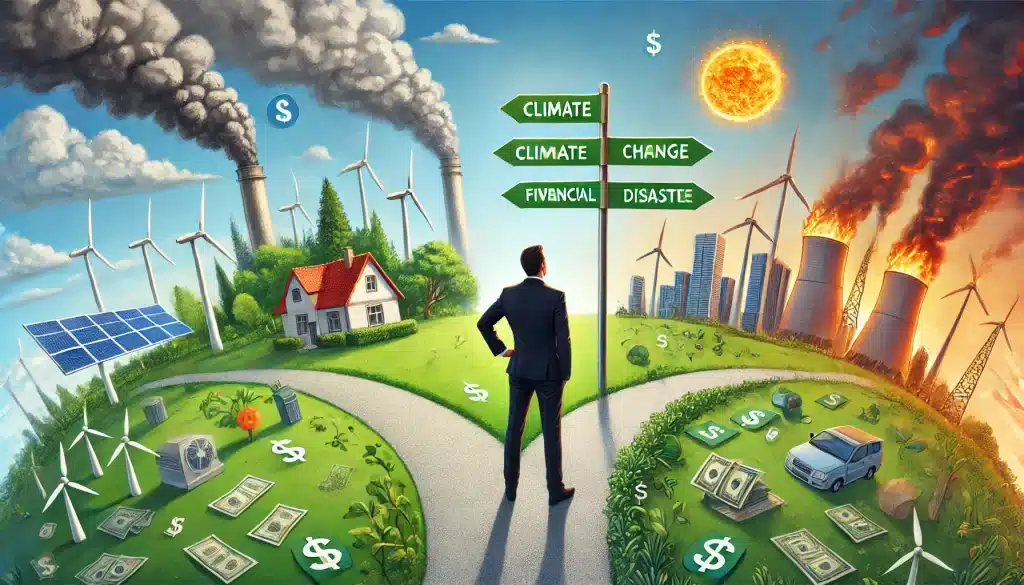Climate change is increasingly impacting our lives, not just environmentally but economically, altering the financial landscape globally. As the planet warms, extreme weather events like hurricanes and wildfires have become more frequent, causing economic strains. These calamities place a significant burden on economies, leading to escalating costs that impact everything from housing to energy.
Given the dual pressures of more frequent natural disasters and financial instability brought on by climate change, effective financial planning has never been more essential. Understanding the economic implications of climate shifts can help individuals and corporations prepare for an uncertain future. By adopting smart strategies, one can mitigate the economic challenges posed by environmental changes, ensuring that financial goals remain within reach.
Climate change and rising costs

The harsh reality of climate change is reflected in the growing frequency of natural disasters such as hurricanes, floods, and wildfires. These events not only devastate communities but also lead to spikes in insurance premiums and inflated costs of basic goods and services. With homes and infrastructures increasingly at risk, insurance companies adjust their rates to cover potential losses, burdening property owners with higher expenses.
Additionally, the rising cost of living, particularly in areas prone to natural disasters, compounds these financial challenges. Infrastructure maintenance, energy prices, and real estate value can fluctuate wildly due to these environmental impacts. Consequently, understanding these economic dynamics is essential for financial planning, aiming to safeguard assets in uncertain times.
Investment risks and sustainable strategies
The financial markets are not immune to the ramifications of climate change. Investors are now facing challenges in assessing risks as the effects of global warming become more pronounced. Markets react to these changes by fluctuating in response to climate-related policies and events, impacting returns on traditional investments.
In response, there’s a notable shift toward ESG (Environmental, Social, and Governance) investing. This strategy focuses on sustainability and can offer higher returns as demand for green energy and sustainable practices grows. Identifying vulnerable sectors versus robust, promising industries is key for investors looking to balance potential risks with opportunities for growth.
Insurance and real estate challenges
Insurance, a crucial tool for managing risk, is heavily affected by the increasing impacts of climate change. As natural disasters become more severe and frequent, the cost and availability of insurance are shifting, particularly in high-risk areas. This presents challenges for both insurers and policyholders, as pricing becomes less predictable.
For real estate, the risks are equally tangible. Properties in areas susceptible to climate events may face depreciating values, leading to potential long-term financial losses. It’s essential for property owners to explore strategies that can mitigate these risks, safeguarding their investments against an unpredictable climate.
Retirement planning in a changing climate
The implications of climate change extend to retirement planning, where inflation and economic instability pose new challenges. As prices rise and economic conditions fluctuate due to environmental factors, retirement savings can be squeezed, jeopardizing future financial security.
Diversification of financial portfolios is a recommended approach to minimize risk exposure. By spreading investments across various sectors, one can better safeguard their savings against climate-induced economic uncertainties, ensuring a stable and secure retirement plan.
Government policies and financial regulations
Governments worldwide are recognizing the financial risks posed by climate change and are implementing policies to encourage sustainable investments. For example, the U.S. Securities and Exchange Commission (SEC) has introduced climate-related disclosure rules to enhance transparency in financial markets. These incentives play a crucial role in guiding financial planning by encouraging shifts toward green finance and sustainable economic activities.
Simultaneously, regulations are being adapted to address the challenges of climate change. These regulations affect how individuals and companies approach financial planning, making it vital to stay informed and compliant. Understanding these policy changes is fundamental to navigating the evolving financial environment.
Practical financial strategies for individuals
For individuals, adapting financial strategies to address the impacts of climate change involves reassessing budgets and investment choices. By planning for potential economic disruptions, individuals can better position themselves to weather financial storms. Practical steps include allocating resources towards sustainable investments and incorporating climate risk assessments into financial decision-making. Exploring smart financial solutions can be a key factor in maintaining economic stability even as the climate continues to change.
Conclusion: Preparing for a climate-resilient financial future
The growing impact of climate change on our financial systems underscores the importance of proactive planning. By understanding the economic implications of environmental shifts, individuals and businesses can better prepare for the future. Seeking specialized financial advice can be a powerful tool in navigating these challenges. A strategic approach to wealth management, mindful of climate risks, ensures resilience in the face of uncertainty. Taking action now can secure a more stable financial future amidst the changing climate landscape.

